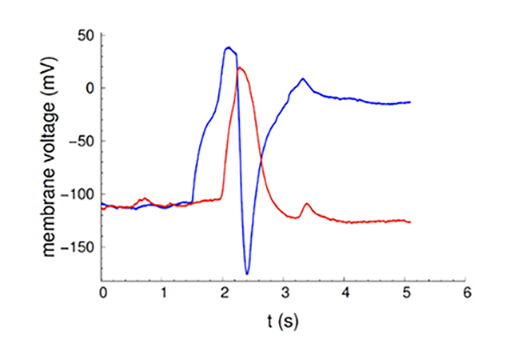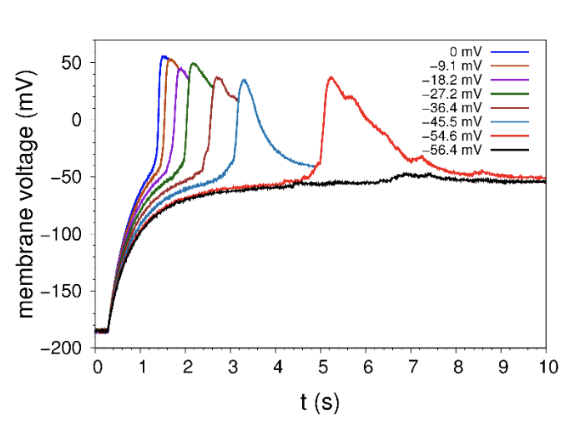Artificial Axon
In the neuron, two opposing gradients of sodium and potassium ions across the cell membrane lead to a non-equilibrium state which, in the presence of voltage gated ion channels, supports a kind of relaxation oscillation which is the action potential. The Artificial Axon consists of a 100 microns size supported bilayer with embedded voltage gated potassium ion channels. In the first version of this developing project, there is only one ionic gradient and one type of ion channel. The system is held off equilibrium by a special kind of voltage clamp with limited current output. This simplified system supports action potentials, that is, it fires in response to an above threshold stimulus. It can in principle display the same basic electrophysiology as neurons, for example, a firing rate which increases with increasing input current.

Two Artificial Axons (blue and red) connected by electronic “synapses”. Blue excites red, red inhibits blue. This system could in principle oscillate.
Just like with other threshold devices, one can implement logic operations, such as AND, OR. However, electrophysiology systems inherently combine analog and digital characteristics. We believe this is the more interesting aspect. You can see a simple application by watching the movie (link). In this (practically rather complicated) demo, a system of two artificial axons is the “brain” which steers the remote control car towards the light source in the SW corner of the screen. The car starts from the NE corner.
With the Artificial Axon, one can study bifurcations in electrophysiology which may be difficult to study quantitatively with living cells. Critical properties are universal and are thus the same, for the same transition, for the Artificial Axon and for an infinitely more complicated living cell.

Series of action potentials in the Artificial Axon evoked by input currents progressively closer to (and above) the firing threshold. The delay time to firing correspondingly increases (critical slowing down).

Critical slowing down measured in the Artificial Axon: delay time to firing vs distance to the critical point. The scaling exponent (slope of the line) is , close to the value expected for a saddle node bifurcation.
An interesting development is that experiments with the Artificial Axon inspired a theoretical study (see below [Pi and Zocchi 2024]) which shows that the electrophysiology of a system with only one voltage gated ion channel species, with inactivation, is equivalent to the electrophysiology of the system with two channel species, without inactivation. The latter exists in the real biological world.
Among the foreseeable future directions is the development of breadboards for electrophysiology research. We conceive that suitable synthetic platforms which incorporate the biological components will one day replace higher animals and their neurons on the lab bench, at least for some studies. A second direction is the development of networks of artificial axons, with signal processing and event storage capabilities; in general, the development of large ionic networks. Yet another scope is the construction of mixed electronics – ionics networks and devices.
Associated publications:
- A. Ariyaratne and G. Zocchi, “Toward a minimal artificial axon”, J. Phys. Chem. B 120, 6255 (2016).
- H. G. Vasquez and G. Zocchi, “Coincidences with the artificial axon”, EPL 119,48003 (2017).
- Hector G. Vasquez, Giovanni Zocchi, “Analog control with two Artificial Axons”, https://arxiv.org/abs/1806.08001 (2018)> ; Bioinspiration and Biomimetics 14, 016017 (2019).
- Giovanni Zocchi, “Opportunities for materials science: from molecules to neural networks”, MRS Bulletin 44, 124 (2019). (Issue on “Bioinspired far-from-equilibrium materials”).
- Ziqi Pi and Giovanni Zocchi, “Critical behavior in the Artificial Axon”, arXiv:2012.00221 (2020) ; J. Phys. Commun. 5, 125013 (2021).
- Xinyi Qi and Giovanni Zocchi, “Kink propagation in the Artificial Axon”, arXiv:2108.06132 (2021) ; EPL 137, 12005 (2022).
- Ziqi Pi and Giovanni Zocchi, “Action potentials in vitro: theory and experiment”, arXiv:2403.03369 (2024) ; Front. Phys. 12, 1452241 (2024).